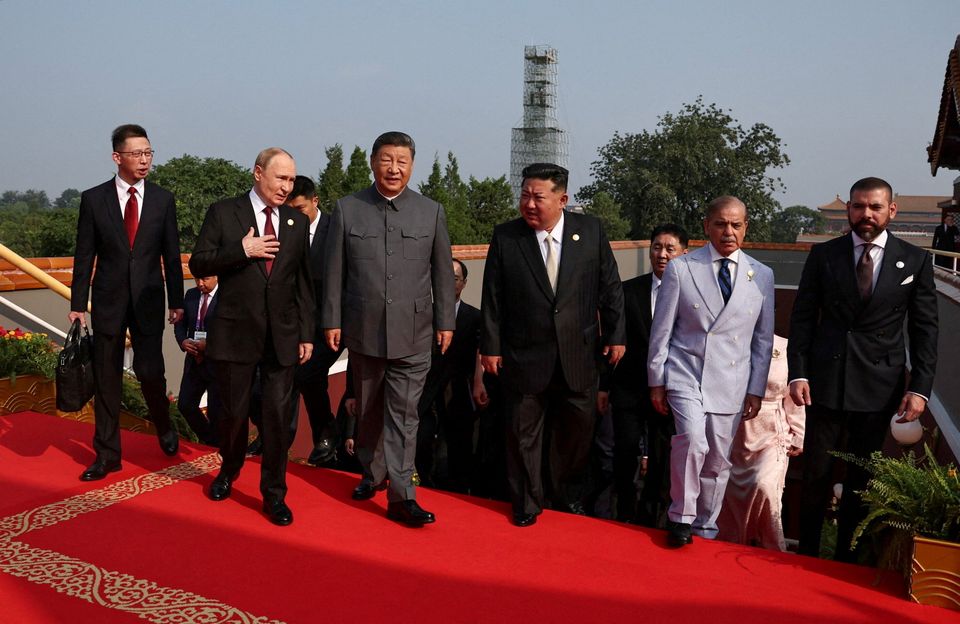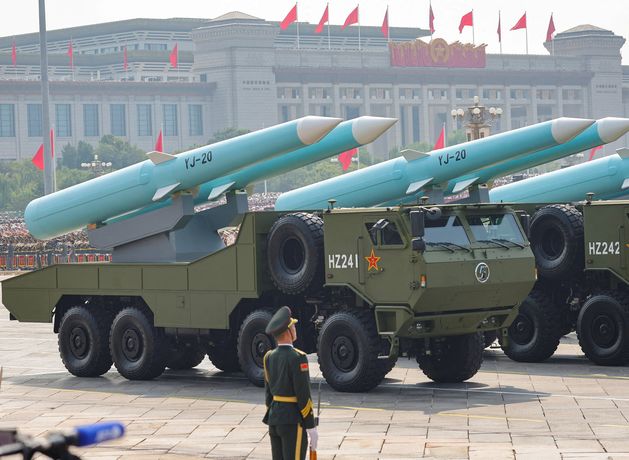Xi says world must choose between ‘peace and war’ at massive military parade in Beijing
Thought to be the largest military parade in China’s history, the event marked the 80th anniversary of Japan’s defeat and the end of World War II.
And while the parade was largely shunned by Western countries, Xi Jinping was flanked by Russian president Vladimir Putin and North Korea’s Kim Jong Un alongside around two-dozen leaders from mostly developing countries and those keen to challenge the US-led world order.
The world’s second-largest economy, which allocated about €214bn for its 2025 defence budget, showcased hypersonic missiles, a new generation of nuclear triad, long-range missiles, anti-drone systems, strategic bombers, and stealth drones – most of them for the first time.
.jpg)
A member of the People’s Liberation Army stands as the maritime operations group displays YJ-20 hypersonic anti-ship missiles in Beijing, China. Photo: Reuters
Today’s News in 90 Seconds – September 4th 2025
The parade began with an 80-gun artillery salute to mark the 80 years since the end of the war. Helicopters trailing large banners and fighter jets flew in formation above during the showcase thick with symbolism and propaganda which culminated in the release of 80,000 peace doves and colourful balloons.
In his speech, the Chinese president warned that the world must choose between “peace and war”.
Watching on from Washington, US president Donald Trump accused Mr Xi, Mr Kim and Putin of “conspiring against” the United States.
“May president Xi and the wonderful people of China have a great and lasting day of celebration,” he posted on social media. “Please give my warmest regards to Vladimir Putin, and Kim Jong Un, as you conspire against The United States of America.”

Russian president Vladimir Putin, Chinese president Xi Jinping, North Korean leader Kim Jong Un, Pakistan’s prime minister Shehbaz Sharif and heads of foreign delegations arrive for a military parade in China. Photo: Reuters
Before the military units began marching, Mr Xi drove past their formations along Beijing’s central Chang’an Avenue in a classic black limousine. He stood in the vehicle’s sunroof with four microphones lined in front of him and greeted flanks of personnel as he passed them and rows of missiles and military vehicles. Marching in the parade were traditional People’s Liberation Army units from the police, navy and army, but also new ones like the cyberspace unit for the first time.
Hypersonic missiles designed to take out ships at sea, a liquid-fuelled intercontinental strategic nuclear missile with the “entire world under its strike range” and space defence systems that could take out foreign satellites, were among some of the most impressive military hardware that China revealed for the world to witness its potential, according to the state media Global Times.
These weapons are of particular concern to the US Navy, which patrols the western Pacific from its 7th Fleet headquarters in Japan.
The Chinese military displayed the new YJ-15 missile along with its pre-existing YJ-17, YJ-19 and YJ-20 hypersonic missiles. The YJ missiles, short for “Ying Ji” or “eagle attack”, can be launched from ships or aircraft and are designed to inflict critical damage on large vessels. China is rapidly advancing in hypersonic weapons technology, a field that has drawn global attention for its ability to evade traditional defence systems.
The anti-ship YJ-21, known as the “carrier killer”, is intended to be used against high-value naval targets. The YJ-21 is capable of supersonic speeds and likely has a range over 600km.
China displayed two types of extra-large uncrewed underwater vehicles (XLUUVs). The sea drone AJX002 is estimated to be around 60ft long, according to reports. Their torpedo-shaped hulls and pump-jet propulsion systems revealed that the underwater vehicles were built to be stealthy.
The AJX002 features four lifting lugs along its hull, indicating that it is crane-assisted. China operates the world’s largest XLUUV programme with at least five distinct types already in the water, according to reports.
China showcased three types of nuclear-capable intercontinental ballistic missiles – Dong Feng-61, Dong Feng-31BJ, and the Dong Feng 5C – for the first time during the victory day parade.
The Chinese army also revealed its first air-launched nuclear missile, the JL-1, which was displayed on a military truck. The JL-1 and JL-3, together with the DF-61 and DF-31, mark the “first concentrated display” of the Chinese army’s “land, sea and air triad strategic nuclear forces”, according to state media CCTV. Yhe Dong Feng 5C has an estimated range of more than 20,000km.
.jpg)
China’s cyber force personnel march in Beijing, China, yesterday. Photo: Reuters
The DF-5C intercontinental strategic nuclear missile has the entire globe under its strike range, the state media added. Experts say the new variant of the Dong Feng 5C is capable of carrying up to 12 warheads on a single missile.
The HQ-29 space defence system, capable of taking down foreign satellites, was displayed for the first time at the parade in a prominent display of aerial power. While not much is known about its exact capabilities, the large size implies an extreme range similar to the US Navy’s SM-3 Block IIA, which can be launched from land or ship.
The Chinese military displayed two versions of ship-based “directed energy” laser weapons at the parade. While one of them was clearly designed for naval air defence, the other one, mounted on a truck, was meant to protect ground troops.
The full range of its anti-drone systems on display at the parade included a missile gun, high-energy laser weapons and high-power microwave weapons.
A number of squadrons of fighter jets and bombers overhead during the parade, some painting the sky with rows of different-coloured exhaust fumes. Helicopters flew in formation, with one group of 26 spelling out the number “80” to signify the WW2 anniversary.
China displayed a legion of robot dogs, highlighting Beijing’s growing emphasis on what it describes as “intelligentised warfare”. The robots, paraded on top of armoured vehicles, could be utilised in the battlefield or weaponised and used in direct combat.
